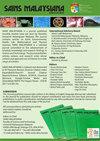Adsorption of Ciprofloxacin Using Composite Film from PVA, Agarose and Maltodextrin
IF 0.8
4区 综合性期刊
Q3 MULTIDISCIPLINARY SCIENCES
引用次数: 0
Abstract
Antibiotic resistance is one of the most alarming problems today. Therefore, composite membranes have been widely applied for the removal of antibiotics from water. PVA/Agarose/Maltodextrin films have been synthesized by casting with various component ratios. They were evaluated for characteristics through moisture, solubility, expansion, and BET results. The results showed that PVA/Agarose/Maltodextrin films exhibited the best viability in the aquatic environment through low solubility (68.88% ± 0.03), high swelling (431.77% ± 5.89) and pore volume (0.034969 cm³/g). The adsorption capacity of PVA/Agarose/Maltodextrin was tested for several antibiotics such as Ciprofloxacin, Tetracycline, Oxy-Tetracycline, and Chloramphenicol. The results showed that Ciprofloxacin was removed by the PVA/Agarose/Maltodextrin films better than other antibiotics. The highest antibiotic adsorption was obtained at 20 min, temperature of 30 °C, dosage of 2 g/L, pH 6, and antibiotic concentration of 40 mg/L. Ciprofloxacin adsorption was predicted through adsorption kinetic and isothermal models. The compatibility of the Pseudo First Order kinetic and Dubinin-Radushkevich isothermal has shown that adsorption takes place according to a physical adsorption mechanism with electrostatic interactions on the surface of the material. The maximum adsorption capacity recorded at 4.48 mg/g based on the Dubinin-Radushkevich isothermal.聚乙烯醇-琼脂糖-麦芽糊精复合膜对环丙沙星的吸附研究
抗生素耐药性是当今最令人担忧的问题之一。因此,复合膜在水中抗生素的去除中得到了广泛的应用。采用浇铸法制备了不同配比的PVA/琼脂糖/麦芽糊精薄膜。通过水分、溶解度、膨胀和BET结果来评估它们的特性。结果表明,PVA/琼脂糖/麦芽糊精膜溶解度低(68.88%±0.03),溶胀度高(431.77%±5.89),孔体积为0.034969 cm³/g,在水环境中具有最佳的生存能力。考察了PVA/琼脂糖/麦芽糖糊精对环丙沙星、四环素、氧四环素、氯霉素等抗生素的吸附能力。结果表明,PVA/琼脂糖/麦芽糊精膜对环丙沙星的去除效果较好。在温度为30℃、用量为2 g/L、pH为6、抗生素浓度为40 mg/L、20 min时,抗生素的吸附效果最佳。通过吸附动力学和等温模型对环丙沙星的吸附进行了预测。伪一级动力学和杜比宁-拉杜什克维奇等温的相容性表明,吸附是根据材料表面静电相互作用的物理吸附机制进行的。根据Dubinin-Radushkevich等温线测定的最大吸附量为4.48 mg/g。
本文章由计算机程序翻译,如有差异,请以英文原文为准。
求助全文
约1分钟内获得全文
求助全文
来源期刊

Sains Malaysiana
MULTIDISCIPLINARY SCIENCES-
CiteScore
1.60
自引率
12.50%
发文量
196
审稿时长
3-6 weeks
期刊介绍:
Sains Malaysiana is a refereed journal committed to the advancement of scholarly knowledge and research findings of the several branches of science and technology. It contains articles on Earth Sciences, Health Sciences, Life Sciences, Mathematical Sciences and Physical Sciences. The journal publishes articles, reviews, and research notes whose content and approach are of interest to a wide range of scholars. Sains Malaysiana is published by the UKM Press an its autonomous Editorial Board are drawn from the Faculty of Science and Technology, Universiti Kebangsaan Malaysia. In addition, distinguished scholars from local and foreign universities are appointed to serve as advisory board members and referees.
 求助内容:
求助内容: 应助结果提醒方式:
应助结果提醒方式:


